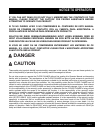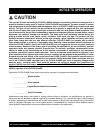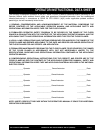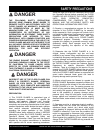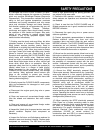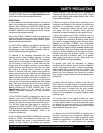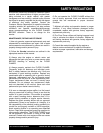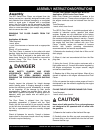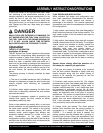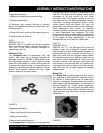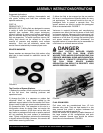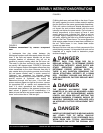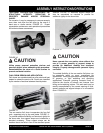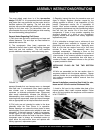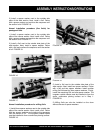
ASSEMBLY INSTRUCTIONS/OPERATIONS
8FP FLOOR PLANER SERIES OPERATION AND PARTS MANUAL REV #2 (05/28/09) PAGE 15
3) Using the funnel, fill the fuel tank with fresh, clean
fuel according to the specifications outlined in the
material supplied by the engine manufacturer. Do not
overfill the tank or spill any fuel. If the fuel tank
incorporates a screen mesh to prevent debris from
falling into the tank, do not remove to increase the fill
rate. Replace the filler cap. Wipe away any excess
spilled fuel.
DANGER
MANY FUELS ARE EXTREMELY FLAMMABLE. DO
NOT SMOKE NEAR THE FUEL TANK. DO NOT FILL
THE FUEL TANK WITH THE ENGINE RUNNING OR
IF IT IS HOT. ALLOW AMPLE TIME BETWEEN
EACH REFUELING FOR THE ENGINE TO COOL.
Operation
THEORY OF OPERATION
Application: All Models.
The 8FP Series Floor Planers operate on the principle
of various flail configurations being operated at high
rotational speeds to make direct contact with a work
surface. A series of flails are spaced and aligned on
shafts that span a specified width and rotate on a
drum that can be raised or lowered at the discretion of
the operator. The specific flail configuration and impact
rate directly affect the rate of material removal from
the work surface, the resulting surface profile and
texture.
The planing process is directly controlled by these
conditions:
1) The use of a suitable mechanism (flail) of sufficient
strength and hardness to impact the work surface and
remove material while delivering an acceptable
service life.
2) Sufficient static weight supporting the flails which
allow them to effectively penetrate the work surface
and remove material.
3) Adequate horsepower capable of propelling the
rotating flails against the work surface to deliver
acceptable productivity rates.
Since no two materials are exactly alike, no two work
surface materials can be penetrated and removed by
the exact sa
me method. The nature of the planing
process, along with operator experience, skill and
common sense, would suggest that efficient and
productive material removal is a matter of trial and
error. Combinations of flail type, condition,
configuration, spacing along the width of the flail drum
and feed rate are direct factors that will determine the
overall success of the job application.
FLAIL DESIGN AND APPLICATION.
While individual flail design and configuration may
vary, basic operational characteristics are identical:
impact a work surface ma
terial a nd remove a
percentage of the material. This common operational
characteristic has led to the development of two basic
flail configurations:
1) High carbon, heat treated, alloy steel designed for
direct contact and removal of the surface material. The
high carbon content of the flail material also helps to
improve service life
2) High carbon, heat treated, alloy steel with tungsten
carbide inserts brazed into the flail body. The tungsten
carbide inserts are intended to directly contact the
work surface and remove material. The inserts
effectively resist wear
and usually deliver a
substantially longer service life than the plain, heat
treated steel types. The flail body is designed to serve
as a matrix or support for the tungsten carbide inserts,
hence the requirement for heat treatment. The heat
treatment process also aids the flail body in resisting
wear.
Several factors directly affect the selection of a
flail design for a specific job application:
1) The type and amount of material to be removed
from the work surface. Materials of higher yield and
tensile strengths along with the actual volume of
material to be removed will generally be the first
factors under consideration.
2) Purchase costs versus service life. The original
purchase cost of plain, heat trea
ted steel flails must be
compared against the substantially higher costs of
tungsten carbide insert flails. In turn, these costs must
be compared to anticipated service life. All flails,
whether of high speed steel or tungsten carbide insert
design, will eventually wear to the point of requiring
replacement. The amount of unproductive time spent
to replace worn flails on a job can be substantially
greater than the actual replacement cost of many
flails. It then becomes a balance between purchase
cost, productivity, service life and labor cost.
3) Surface finish and texture. The finest grained
surface finish available from the planing process is
comparable to a "swept or broomed" like finish.
FIGURE 1. If a smooth, flat finish is desired, the
planing process must be followed with a grinding or
polishing type process. Many job requirements may
call for large amounts of material to be removed, but
followed with additional specifications requiring a finer
surface finish or texture. Many times these jobs dictate



